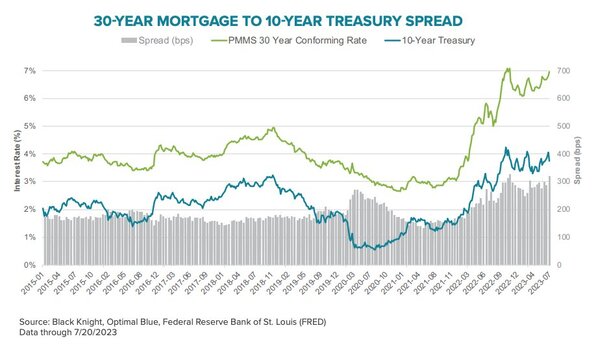Whereas Fed price hike forecasts point out the worst is behind us, mortgage charges are nonetheless going up.
Actually, they hit a brand new 52-week excessive this morning, surpassing the temporary highs seen again in October.
That places the 30-year fastened at its highest stage in additional than 20 years, averaging round 7.5%.
It will probably grind the housing market to a halt, which was already grappling with affordability woes previous to this most up-to-date leg up in charges.
The query is why are mortgage charges nonetheless growing if long-term indicators point out that aid is in sight?
The 30-Yr Mounted Mortgage Is Now Priced Near 7.5%
Relying on the info you depend on, the favored 30-year fastened is now averaging roughly 7.5%, up from round 6% to begin the yr.
If we return to the beginning of 2022, this price was nearer to three.5%, which is a stunning 115% improve in little over a yr.
And whereas mortgage charges within the Eighties had been considerably increased, it’s the velocity of the rise that has crushed the housing market.
Moreover, the divide between excellent mortgage charges held by current owners and prevailing market charges has created a mortgage price lock-in impact.
In brief, the upper mortgage charges go, the much less incentive there may be to promote your property, assuming that you must purchase a substitute.
Except for it being extraordinarily unattractive to commerce a 3% mortgage for a price of seven% or increased, it may be out of attain for a lot of because of sheer unaffordability.
As such, the housing market will probably enter the doldrums if mortgage charges stay at these 20-year highs.
However Isn’t the Fed Finished Climbing Charges?

As a fast refresher, the Federal Reserve doesn’t set client mortgage charges, however it does make changes to its personal federal funds price.
This short-term price can dictate the route of longer-term charges, equivalent to 30-year mortgages, which monitor the 10-year Treasury fairly reliably.
Mortgage-backed securities (MBS) and 10-year bonds entice the identical buyers as a result of the loans usually final the identical period of time.
Usually, buyers get a premium of about 170 foundation factors (1.70%) once they purchase MBS versus government-guaranteed bonds.
Recently, these mortgage spreads have practically doubled, to over 300 foundation factors, as seen in Black Knight’s graphic above, due to normal volatility and an expectation these loans will probably be refinanced sooner somewhat than later.
However what’s unusual is each the 10-year yield and mortgage charges have continued to rise, regardless of the Fed’s tightening marketing campaign being seemingly over.
As an instance, a current Reuters ballot discovered that the Fed is probably going executed elevating rates of interest, “in keeping with a powerful majority of economists.”
And we’re speaking robust. A 90% majority, or 99 of the 110 economists, polled between August 14-18, consider the federal funds price will stand pat at its 5.25-5.50% vary throughout the September assembly.
And about 80% of those economists anticipate no additional price hikes this yr, which tells you we’ve already peaked.
In the meantime, a majority among the many 95 economists who’ve forecasts by means of mid-2024 consider there will probably be a minimum of one price lower by then.
So not solely are the Fed price hikes supposedly executed, price cuts are on the horizon. Wouldn’t that point out that there’s aid in sight for different rates of interest, equivalent to mortgage charges?
Mortgage Charges Want Some Convincing Earlier than They Fall Once more
As I wrote final week in my why are mortgage charges so excessive submit, no person (together with the Fed) is satisfied that the inflation struggle is over.
Sure, we’ve had some first rate experiences that point out falling inflation. However declaring victory appears silly at this juncture.
We haven’t actually skilled a lot ache, because the Fed warned when it started mountain climbing charges in early 2022.
The housing market additionally stays unfettered, with residence costs rising in lots of areas of the nation, already at all-time highs.
So to assume it’s job executed would seem loopy. As a substitute, we’d see a cautious return to decrease charges over an extended time frame.
In different phrases, these increased mortgage charges is perhaps sticky and arduous to shake, as an alternative of a fast return to 5-6%, or decrease.
On the similar time, the argument for 8% mortgage charges or increased doesn’t appear to make a number of sense both.
The one caveat is that if the Fed does change its thoughts on price hikes and resume its inflation struggle.
However that will require most economists to be fallacious. The opposite wrinkle is elevated Treasury issuance due to authorities spending and concurrent promoting of Treasuries by different nations.
This might create a provide glut that decrease costs and will increase yields. However keep in mind mortgage charges can tighten up significantly versus Treasuries as a result of spreads are double the norm.
To sum issues up, I consider mortgage charges took longer than anticipated to succeed in cycle highs, will keep increased for longer, however probably gained’t go a lot increased from right here.
Now that short-term charges appear to have peaked, because the Fed watchers point out, long-term charges might want to slowly digest that and act accordingly.
Within the meantime, we’re going to see even much less for-sale stock hit the market at a time when provide has hardly ever been decrease. This could a minimum of hold residence costs afloat.


